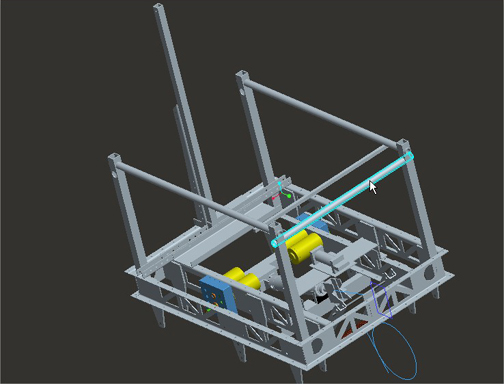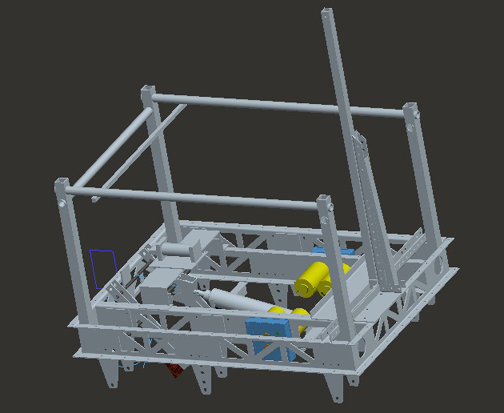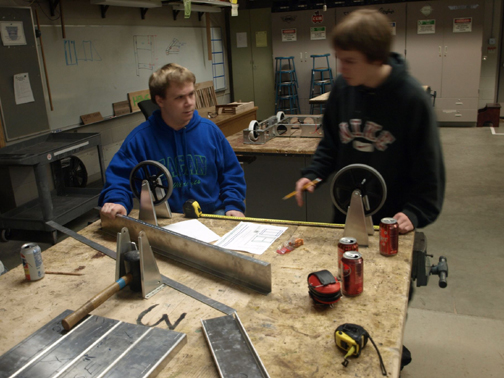Latest News
March 9, 2010



In February, First Robotic Team 2220, dubbed Blue Twilight, discovered that their robot had a knee problem.
Ed Anderson, one of the team’s mentors, summed up the issues:
- The knee joint absorbed too much energy.
- The use of a pneumatic piston as primary energy source was inadequate to deliver a powerful enough kick in the first place.
The other issue was the piston placement. “Our first choice of an anchor point for the piston was nixed because it turned out that the [sub-team designing the lifter] needed to mount their motor right there,” explained Ed. “Our second choice turned out to be suboptimal because mounting it there would have required the drive [sub-team working on the drive train] to disassemble and reassemble their two gearboxes [a procedure estimated to take four hours].”
Eventually, the team attached the piston to a point below the frame. “Once again, Pro/ENGINEER [the team’s primary CAD package] helped us zero in on the correct mount point and shim size,” noted Ed.
Next came the challenge to activate the gate latch trigger. “The stock latch had a very short handle that, when under pressure, was very difficult to trip,” noted Ed. “We found that bolting a six-inch strip of metal to it (a lever, in other words) decreased the force necessary to move the latch. Unfortunately, the handle was weak at the bolt points, and actually broke during the test. Alex [Ed’s son and the team’s designated CAD designer] had to [draw in Pro/ENGINEER] a whole new latch ... with a longer handle, with more material around the stress points, and thicker.”
The initial idea to use a motor or solenoid to open the gate latch and kick the ball was also modified. “We quickly realized that, when pressurized, it was going to take far more force to open than a small motor or solenoid would be able to deliver,” Ed said. “We were already using pneumatics to load the kicker; why not use another piston to trip the latch? Again, the location of this piston would be a challenge. It had to be in proximity to the gate latch, but out of the path of travel of the top bar. Pro/ENGINEER showed that we could build a small shelf over the mechanism that would be ideal.”
Alex outlined other design modifications prompted by the tests and discoveries:
- The lift group’s original hook to grab the bar on the tower to [let the robot] lift [itself] up was made from a square beam. [This self-lifting move, if executed during contest, helps the team score additional points.] They decided instead to forge a curved question mark-shaped hook in order to hopefully prevent the robot from slipping off the hook.
- The bars along the top of the robot are there in order to allow other robots to hang off of them [another move that helps score points]; when [the team] tested it, it was able to lift two 150-pound students.
- After testing the kicking mechanism, which is powered by bungees and reset and triggered with pneumatic pistons, [the team] realized that it was a potential hazard, so [students] created a safety device, which a team member can slip on between the frame and the foot. This prevents it from accidentally kicking someone.
The matches typically start with a 15-second autonomous found, a phase in which robots must move strictly by the programmers’ code. This was followed by the teleoperated period, the phase in which human drivers control the robots using joysticks. In the last 20 seconds, the robots could score extra points by hanging from the tower, which Team 2220 was able to do. The short video clip below, provided by Ed Anderson, shows the thrilling moments in the mini-regional.
For more on Blue Twilight, read the following posts:
This month, with 3D printer developer Solido‘s help, the team is creating physical prototypes of some of the critical parts in the machine.
Subscribe to our FREE magazine, FREE email newsletters or both!
Latest News
About the Author
Kenneth Wong is Digital Engineering’s resident blogger and senior editor. Email him at [email protected] or share your thoughts on this article at digitaleng.news/facebook.
Follow DERelated Topics






